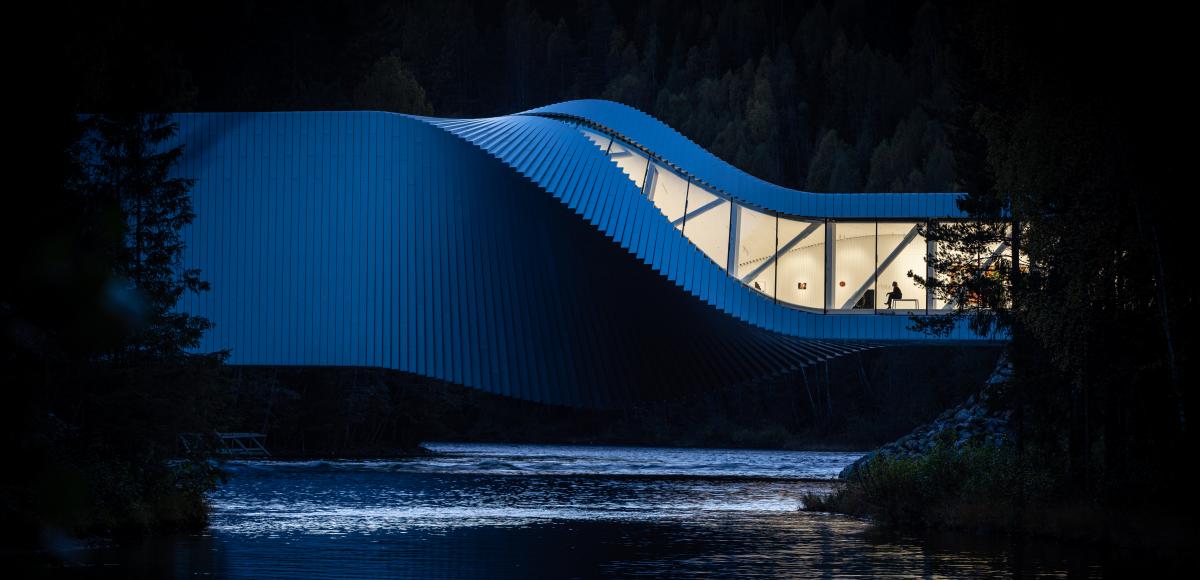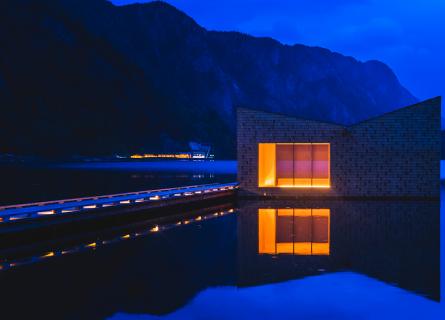
Holistic Lighting design at The Twist where architecture, art and the users are at the centre of attention.
The Twist, Kistefos Museum, Norway
Spanning across the Randselva River a new bridge twists through the scenic landscape as a natural extension of the existing sculpture park in Kistefos. The building acts as an artwork in itself and is designed to exhibit art inside its spacious and bright gallery.
As daylight enters through the curved panoramic windows electric lighting smooths out the luminance contrasts in the space whilst adding an extra glow to the exhibited art. The overall lighting concept is designed to minimize reflections in the panoramic window to ensure the best view for visitors both outside and inside The Twist.
Lighting Concept
Danish architects BIG - Bjarke Ingels Group who created this magnificent work of art clearly specified they wanted particularly well-lit exhibition rooms and a highly uniform lighting effect. In order to achieve this, all light levels have been carefully fitted to the natural light levels inside the building with supplementary spotlights directed towards the paintings and sculptures. No unnecessary or decorative light sources have been installed, to minimize inconvenience and distractions in the minimalistic space.
The lighting concept for The Twist is entitled “The Art, The spectator, The space”. It is developed with an aim to accommodate the building’s main purpose, namely to allow visitors to experience and explore the art and the architectural space without any unnecessary disturbance, as well as enhance the gallery’s magnificent sculptural shape. For any lighting task, it is crucial that the optics used are the ones best suited for the purpose to avoid over-illumination or glare, which will jeopardize the overall experience of a space – a task which this project perfectly demonstrates. In harmonious interplay with its natural surroundings, The Twist is a very beautiful showroom with varied light sources which enhance the architecture and exhibited art whilst ensuring undisturbed views of the river.
Daylight Design
A glass staircase leads down to the art gallery's lower level on the northern riverbank with the full-height glass walls. The clear view of the river brings the visitors close to the surrounding nature and adds a magnificent experience of being in immersed with nature. However, the full-height glass walls posed a unique challenge for the intended video projections on the glass staircase.
Light Bureau’s daylight specialists were engaged to undertake daylight study of this area and ensure that the frosted glass projection surface could produce a crisp image with an appropriate level of contrast inside the space. The geometry of the structure, the generous daylight openings in combination with reflections from the water below, as well as shade from the surrounding hillsides, added significant complexity to the study. All elements were carefully modelled and tested for all seasons and time of the day using simulations so that the projections were feasible at all times and during all seasons. The daylight studies clearly showed that the glass staircase received high levels of daylight illumination during specific time of the year and day, and appropriate strategies were suggested to reduce the amount of daylight in this space.
The result
In order to create such a well-lit exhibition space, Light Bureau made use of a 4000K neutral white light colour. The wall washers ensure a lighting effect that is as uniform as possible and at the same time enhance the architecture. While the carefully aligned spotlights bring out the very best in the textures, shapes and colours of the exhibition. From an aesthetic point of view, the minimalist design of the luminaires with its simple cylindrical form adds a highly uniform, discrete appearance within the spectacular exhibition spaces.
The solution is a sustainable lighting design which follows the design strategy of adding light where needed, when needed, and to the amount needed, with no unnecessary luminaires installed. In addition, all luminaires are high quality LED fixtures with low energy consumption. Overall, the lighting design at The Twist places architecture, art and the users at the centre of attention.
Facts about the project
- Client: Kistefos Museum
- Architects: BIG Bjarke Ingels Group, Copenhagen/ Denmark (Partner in charge: Bjarke Ingels, David Zahle; head of project: Eva Seo-Andersen; project architect: Mikkel Marcker Stubgaard)
- Interior design: Guy Robertsen
- Electrical planning: Rambøl1/ Strøm-Hansen
- Lighting design: Light Bureau part of AFRY


Interested in our offering? Contact us!

